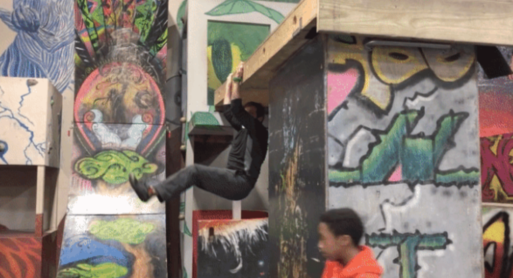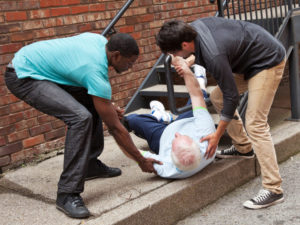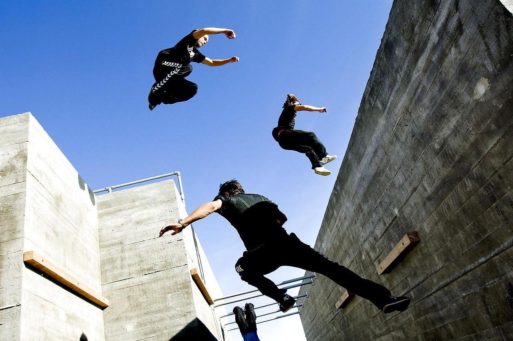The sport and training method known as parkour is generally considered to be a young person’s endeavor. However, it is being touted as a new method to potentially teach older citizens how to fall “better” in order to prevent injuries or even death resulting from a fall.
Parkour is a free-form, very acrobatic sport that resembles gymnastics and is usually practiced in urban environments. Picture participants leaping from bike racks to fire hydrants to bus stops, back-flipping off of walls, quickly climbing fire escapes, and jumping between rooftops. You could definitely call it an extreme sport, particularly depending on where people choose to parkour.
At least that’s the way that most of us will learn about the sport. Internet videos almost always focus on the gnarlier and more impressive feats. However, parkour is not only about speed, agility, jumping and back flips. Participants also need to learn how to land, or “fall” properly to mitigate injury, which is where the application for older adults comes into play.
People of any age can learn parkour basics at dedicated facilities across the country. There are now some parkour groups that offer modified courses for older adults looking to stay active into retirement. The instincts that are taught in these courses could save them at some point from serious injury or even death during a fall.

Urban Evolution parkour gym where older folks do parkour too
Credit: citylab.com screen shot (Linda Poon)
Blake Evitt runs Parkour Generations Boston. His group, part of the national organization Parkour Generations Americas, is offering an eight-day course starting in January in Brookline, Massachusetts, that is catering to adults aged 50 and older. The class is pegged in an adult-course catalog as teaching “how to avoid falls, or how best to fall if it happens, [and] how to turn obstacles into opportunities.”
Parkour is about progression, according to Evitt, and moves can be tailored to match each person’s abilities. “A lot of what we do,” he says, “is not jumping in between buildings and doing flips and tricks…It’s strengthening [your body], having fun with movement and adapting to the environment.”
Falls A Leading Cause of Death
More of America’s Baby Boomers are hitting retirement age, with 10,000 turning 65 every day. According to a report from the Centers for Disease Control and Prevention, about one in four U.S. residents aged 65 and up report falling at least once each year.
And deaths from those falls are on the rise. In 2007, 18,334 U.S. residents died as a result of falling; that number rose to 29,668 in 2016. That equates to roughly a 30 percent increase, from 47 deaths per 100,00 to 61.6 deaths per 100,000, respectively.

Credit: npr.org
It’s not just falls that lead to death we need to worry about. Non-fatal falls are a big problem as well, as they can severely limit a person’s quality of life. Broken bones, shattered hips, cuts, gashes and head injuries can all result from a fall. These falls also have psychological impacts.
“Many older adults who have experienced a fall, or know someone who has, develop this fear of falling, which can restrict their activity,” says Kathy Cameron, director of the Falls Prevention Resource Center at the National Council on Aging. “And the less active they are, the more their balance and muscle strength will decline, which puts them at greater risk of [falling again] and of social isolation and depression.”
Parkour And Learning to “Fall”
Salil Maniktahla is an instructor at and also the owner of Urban Evolution in Alexandria, Virginia. In one class for people aged 35 and older, he teaches participants how to tumble properly in order to avoid injury. Participants pretend to trip over a ledge, and then employ one of two methods: a forward roll or a sideways roll.
“The short answer is that the more you do it, the better you are at falling,” Maniktahla says. “The more you practice, the more you’re going to know what to do.”
It’s important to remember that falls can happen in a split second, which is not to discredit parkour. Cameron is hopeful that these classes will be approved and eventually added to the NCOA’s recommended activities list for fall prevention. More research into the benefits of parkour is needed before that can happen, though.
The benefits of parkour for older adults lie mainly in changing the way that people instinctively move. Ideally, when in an unforeseen circumstance, people trained in parkour would be able to “fall” in a way that mitigates harm because it’s become a habit rather than a planned course of action.

 Parkour, Older Adults and “Falling Better”
Parkour, Older Adults and “Falling Better”



 “Help Me, Helen”
“Help Me, Helen”

 “As Tears Go By” by Marianne Faithfull
“As Tears Go By” by Marianne Faithfull














